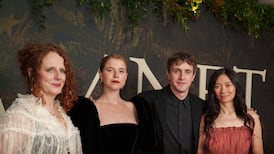It is one of the most famous images in art history, a painting deemed so scandalous that when it went on display at the Musée d’Orsay in 1995 it was mounted behind glass and given its own security guard out of fear that offended visitors might resort to violence.
L’Origine du Monde (The Origin of the World), by the 19th-century French painter Gustave Courbet, shows a naked woman’s lower torso and crotch, her breasts partially covered with a white sheet, her face and arms cropped out altogether.
The painting’s daring realism has been celebrated as a cut at bourgeois hypocrisy, but Courbet’s masterpiece was considered so shocking to 19th-century sensibilities that it was not even exhibited publicly until the 1980s.


Many experts believe the unidentified model was Irish-born Joanna “Jo” Hiffernan, known in artistic circles as La Belle Irlandaise, who was lover and muse to both Courbet and American artist James McNeill Whistler.
Described in 19th-century accounts as a keen wit whose glorious red hair captivated admirers, Hiffernan appears in a number of Courbet’s paintings, but it is her role in his most provocative work that has stirred most debate.
Yesterday that debate took an unexpected turn when Paris Match magazine published a front-page “world exclusive” claiming an amateur art collector had found the top half of Courbet’s portrait.
The collector, identified only as “John”, told the magazine he bought the canvas of a woman’s head from a Paris antiques dealer in early 2010 for €1,400 after spotting it nestled between old furniture and knick-knacks. He is convinced the 41cm x 33cm head is the work of a master and has spent two years trying to confirm his suspicions.
Courbet expert Jean-Jacques Fernier has given weight to the hypothesis, saying the unsigned painting appeared to have been cut off a bigger work and the weave of its canvas matched that of Courbet’s masterpiece. If confirmed, the newly discovered painting could fetch up to €35 million.
Scepticism
Although Paris Match says the painting has been authenticated by X-ray and infra-red examination, many experts are sceptical and opinions differ on the sitter’s resemblance to Hiffernan.
In Le Monde, art critic Philippe Dagen dismissed the latest claims. The stylistic similarities were “dubious”, he said, while the lighting and skin texture were clearly different. The matching canvas could be explained by the fact that all Parisian painters had the same suppliers, according to the critic. And what of the out-of-sync angles, the torso turned slightly to the right, the head facing left? “For a painter as attentive to the reality of the body as Courbet, this absurdity would be at the very least strange,” Dagen wrote.
Courbet, a pioneer of 19th-century realism, is believed to have painted L’Origine as a commission for e Turkish-Egyptian diplomat Khalil-Bey, a flamboyant society figure who kept the canvas in his bathroom behind a green curtain.
It was donated to the Musée d’Orsay in 1995 after the death of its then owner, the psychoanalyst Jacques Lacan.
The painting’s shock value may have receded, but not every museum treats it quite like any other masterpiece.
When the Metropolitan Museum of Art in New York secured it on loan for its Courbet retrospective in 2008, staff took care to place it in a secluded passageway.










